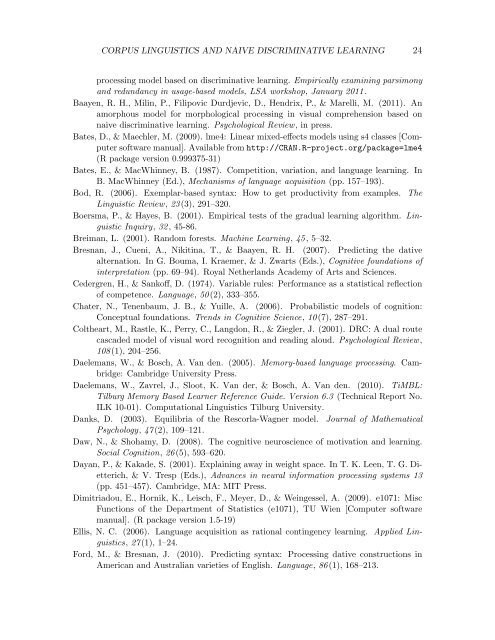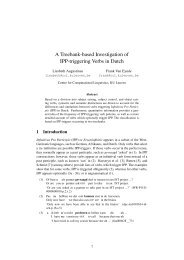Corpus linguistics and naive discriminative learning - University of ...
Corpus linguistics and naive discriminative learning - University of ...
Corpus linguistics and naive discriminative learning - University of ...
You also want an ePaper? Increase the reach of your titles
YUMPU automatically turns print PDFs into web optimized ePapers that Google loves.
CORPUS LINGUISTICS AND NAIVE DISCRIMINATIVE LEARNING 24<br />
processing model based on <strong>discriminative</strong> <strong>learning</strong>. Empirically examining parsimony<br />
<strong>and</strong> redundancy in usage-based models, LSA workshop, January 2011 .<br />
Baayen, R. H., Milin, P., Filipovic Durdjevic, D., Hendrix, P., & Marelli, M. (2011). An<br />
amorphous model for morphological processing in visual comprehension based on<br />
<strong>naive</strong> <strong>discriminative</strong> <strong>learning</strong>. Psychological Review, in press.<br />
Bates, D., & Maechler, M. (2009). lme4: Linear mixed-effects models using s4 classes [Computer<br />
s<strong>of</strong>tware manual]. Available from http://CRAN.R-project.org/package=lme4<br />
(R package version 0.999375-31)<br />
Bates, E., & MacWhinney, B. (1987). Competition, variation, <strong>and</strong> language <strong>learning</strong>. In<br />
B. MacWhinney (Ed.), Mechanisms <strong>of</strong> language acquisition (pp. 157–193).<br />
Bod, R. (2006). Exemplar-based syntax: How to get productivity from examples. The<br />
Linguistic Review, 23 (3), 291–320.<br />
Boersma, P., & Hayes, B. (2001). Empirical tests <strong>of</strong> the gradual <strong>learning</strong> algorithm. Linguistic<br />
Inquiry, 32 , 45-86.<br />
Breiman, L. (2001). R<strong>and</strong>om forests. Machine Learning, 45 , 5–32.<br />
Bresnan, J., Cueni, A., Nikitina, T., & Baayen, R. H. (2007). Predicting the dative<br />
alternation. In G. Bouma, I. Kraemer, & J. Zwarts (Eds.), Cognitive foundations <strong>of</strong><br />
interpretation (pp. 69–94). Royal Netherl<strong>and</strong>s Academy <strong>of</strong> Arts <strong>and</strong> Sciences.<br />
Cedergren, H., & Sank<strong>of</strong>f, D. (1974). Variable rules: Performance as a statistical reflection<br />
<strong>of</strong> competence. Language, 50 (2), 333–355.<br />
Chater, N., Tenenbaum, J. B., & Yuille, A. (2006). Probabilistic models <strong>of</strong> cognition:<br />
Conceptual foundations. Trends in Cognitive Science, 10 (7), 287–291.<br />
Coltheart, M., Rastle, K., Perry, C., Langdon, R., & Ziegler, J. (2001). DRC: A dual route<br />
cascaded model <strong>of</strong> visual word recognition <strong>and</strong> reading aloud. Psychological Review,<br />
108 (1), 204–256.<br />
Daelemans, W., & Bosch, A. Van den. (2005). Memory-based language processing. Cambridge:<br />
Cambridge <strong>University</strong> Press.<br />
Daelemans, W., Zavrel, J., Sloot, K. Van der, & Bosch, A. Van den. (2010). TiMBL:<br />
Tilburg Memory Based Learner Reference Guide. Version 6.3 (Technical Report No.<br />
ILK 10-01). Computational Linguistics Tilburg <strong>University</strong>.<br />
Danks, D. (2003). Equilibria <strong>of</strong> the Rescorla-Wagner model. Journal <strong>of</strong> Mathematical<br />
Psychology, 47 (2), 109–121.<br />
Daw, N., & Shohamy, D. (2008). The cognitive neuroscience <strong>of</strong> motivation <strong>and</strong> <strong>learning</strong>.<br />
Social Cognition, 26 (5), 593–620.<br />
Dayan, P., & Kakade, S. (2001). Explaining away in weight space. In T. K. Leen, T. G. Dietterich,<br />
& V. Tresp (Eds.), Advances in neural information processing systems 13<br />
(pp. 451–457). Cambridge, MA: MIT Press.<br />
Dimitriadou, E., Hornik, K., Leisch, F., Meyer, D., & Weingessel, A. (2009). e1071: Misc<br />
Functions <strong>of</strong> the Department <strong>of</strong> Statistics (e1071), TU Wien [Computer s<strong>of</strong>tware<br />
manual]. (R package version 1.5-19)<br />
Ellis, N. C. (2006). Language acquisition as rational contingency <strong>learning</strong>. Applied Linguistics,<br />
27 (1), 1–24.<br />
Ford, M., & Bresnan, J. (2010). Predicting syntax: Processing dative constructions in<br />
American <strong>and</strong> Australian varieties <strong>of</strong> English. Language, 86 (1), 168–213.
















